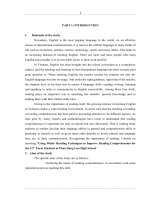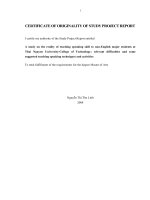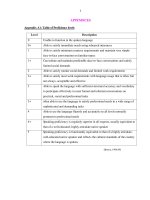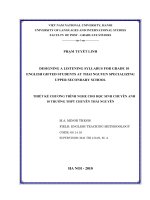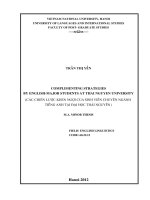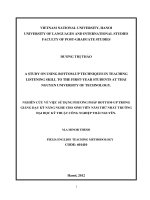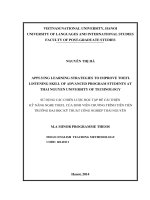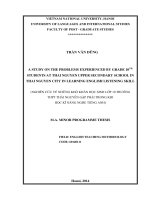Applying learning strategies to improve TOEFL listening skill of Advanced Program students at Thai Nguyen University of Technology
Bạn đang xem bản rút gọn của tài liệu. Xem và tải ngay bản đầy đủ của tài liệu tại đây (748.21 KB, 67 trang )
VIETNAM NATIONAL UNIVERSITY, HANOI
UNIVERSITY OF LANGUAGES AND INTERNATIONAL STUDIES
FACULTY OF POST-GRADUATE STUDIES
NGUYỄN THỊ HÀ
APPLYING LEARNING STRATEGIES TO IMPROVE TOEFL
LISTENING SKILL OF ADVANCED PROGRAM STUDENTS AT
THAI NGUYEN UNIVERSITY OF TECHNOLOGY
SỬ DỤNG CÁC CHIẾN LƢỢC HỌC TẬP ĐỂ CẢI THIỆN
KỸ NĂNG NGHE TOEFL CỦA SINH VIÊN CHƢƠNG TRÌNH TIÊN TIẾN
TRƢỜNG ĐẠI HỌC KỸ THUẬT CÔNG NGHIỆP THÁI NGUYÊN
M.A MINOR PROGRAMME THESIS
FIELD: ENGLISH TEACHING METHODOLOGY
CODE: 60140111
Hanoi, 2014
VIETNAM NATIONAL UNIVERSITY, HANOI
UNIVERSITY OF LANGUAGES AND INTERNATIONAL STUDIES
FACULTY OF POST-GRADUATE STUDIES
NGUYỄN THỊ HÀ
APPLYING LEARNING STRATEGIES TO IMPROVE TOEFL
LISTENING SKILL OF ADVANCED PROGRAM STUDENTS AT
THAI NGUYEN UNIVERSITY OF TECHNOLOGY
SỬ DỤNG CÁC CHIẾN LƢỢC HỌC TẬP ĐỂ CẢI THIỆN
KỸ NĂNG NGHE TOEFL CỦA SINH VIÊN CHƢƠNG TRÌNH TIÊN TIẾN
TRƢỜNG ĐẠI HỌC KỸ THUẬT CÔNG NGHIỆP THÁI NGUYÊN
M.A MINOR PROGRAMME THESIS
FIELD: ENGLISH TEACHING METHODOLOGY
CODE: 60140111
Supervisor: DUONG DUC MINH, PhD.
Hanoi, 2014
i
DECLARATION
This thesis is a presentation of my original research work. Wherever
contributions of other sare involved, every effort is made to indicate this clearly,
with due reference to the literature, and acknowledgement of collaborative research
and discussions. The work was done under the guidance of my supervisor, Dr
Duong Duc Minh, at the University of Languages and International Studies, VNU.
Student‟s signature
Nguyen Thi Ha
In my capacity as supervisor of the candidate‟s thesis, I certify that the above
statements are true to the best of my knowledge.
Hanoi, August 18
th
2014
Supervisor
Duong Duc Minh, Ph.D.
ii
ACKNOWLEDGEMENTS
Writing a thesis, especially in such a limited time, was one of the most
challenging things I have ever gone through. In this demanding process, I was lucky
enough to have the support of several people.
First and foremost, I would like to express my deep thank to my advisor, Dr.
Duong Duc Minh for all his efforts, for not only being a very hardworking advisor,
but also an understanding counselor. He never left me without an answer to my
never-ending questions; he was always so quick to give feedback that I could finish
my thesis on time thanks to him.
I also would like to thank the Faculty of Post Graduate Studies, University
of Languages and International Studies, Hanoi National University for granting
me the opportunity to pursue
my
studies and
my
research.
I am grateful to my collegues and my friends, who are always willing to
share with me any kinds of work, documents or experience in doing a thesis. They
also symphathize with with my difficulties as well as my fault in life.
Last but not least, I owe my genuine, deepest gratitude to my family for their
everlasting belief in me, for always encouraging me. They have been the strongest
motivation for me to pursue my degree. I am indebted to my family, especially my
parents who are always ready to look after my little daughter. Without the support
from my family members, I would not have finished my thesis.
iii
ABSTRACT
The purpose of the current study was to examine the frequency of
listening strategies use by Advanced Program students at Thai Nguyen University
of Technology and the relationship between listening strategy use and their
language proficiency level. A total of 40 students were involved in this study. The
results of TOEFL test were employed to identify the learners‟ listening proficiency
levels and a survey was developed and administered in which questionnaires were
used to investigate the frequency of listening strategies use by Advanced Program
students. The reported listening strategies use for this study are limited to
metacognitive, cognitive, social and affective strategies. The findings of this study
show that Advanced program students reported employing meta-cognitive
strategies more frequently and actively; followed by cognitive and socio-affective
listening strategies. The results of the Analysis of Variance (ANOVA)
showed that there was significant difference between listening strategy use and
language proficiency levels of students. Based on the results obtained from the
study, it is recommended that teachers should aware of listening strategies and
should have effective teaching methods to help students improve their listening skill
when doing TOEFL listening test.
iv
LIST OF ABBREVIATIONS
ANOVA : Analysis of Variance
AP : Advanced Program
SPSS : Statistical Package for Social Sciences
TNUT : Thai Nguyen University of Technology
TOEFL : Test of English as a Foreign Language
v
LIST OF CHARTS AND TABLES
CHARTS
Chart 1: TOEFL score obtained by AP students 22
TABLES
Table 1: Content Validity of the Listening Strategies verified by 5 experts 30
Table 2: Pre-listening Planning Strategies 34
Table 3: While-listening Monitoring Strategies 35
Table 4: Post-listening Evaluation Strategies 35
Table 5: Cognitive Formal Practicing Strategies 36
Table 6: Bottom-up Strategies 37
Table 7: Top-down strategies 37
Table 8: Social Strategies 38
Table 9: Affective Strategies 39
Table 10: Variation in Frequency of Use of Listening Strategies According to
Language Proficiency Level 40
vi
TABLE OF CONTENTS
DECLARATION i
ACKNOWLEDGEMENTS ii
ABSTRACT iii
LIST OF ABBREVIATIONS iv
LIST OF CHARTS AND TABLES v
TABLE OF CONTENTS vi
PART A: INTRODUCTION 1
1. Rationale of the study 1
2. Aims of the study 2
3. Research Questions 2
4. Scope of the study 3
5. Methods of the study 3
6. Design of the study 3
PART B: DEVELOPMENT 5
CHAPTER 1: LITERATURE REVIEW 5
1.1. Learning Strategies 5
1.1.1. Definition of Learning Strategies 5
1.1.2. Classification of Learning Strategies 6
1.1.2.1. O'Malley's (1985) Classification of Language Learning Strategies 6
1.1.2.2. Rubin's (1987) Classification of Language Learning Strategies 7
1.1.2.3. Oxford's (1990) Classification of Language Learning Strategies 8
1.1.2.4. Stern's (1992) Classification of Language Learning Strategies 9
1.2. Listening Strategies 11
1.2.1. Definitions of Listening by Different Researchers 11
1.2.2. The importance of listening 12
1.2.3. Overview of listening strategies 13
vii
1.3. Previous studies in the world and in Vietnam 16
CHAPTER 2: METHODOLOGY 21
2.1. Participants and setting of the study 21
2.1.1. Participants 21
2.2.2. Setting of the study 23
2.2. Data Collection 24
2.2.1. Data Collection Instruments 24
2.2.1.1. Interview 24
2.2.1.2. Classroom observation 25
2.2.1.3. Think-aloud Protocols 26
2.2.1.4. Diary studies 26
2.2.1.5. Written Questionnaire 27
2.2.2. Data Collection Procedures 31
2.2.3. Data analysis 32
2.2.3.1. SPSS Software 32
2.2.3.2. Analysis of Variance (ANOVA) 32
2.2.3.3. The post-hoc Scheffé Test 32
CHAPTER 3: FINDINGS AND DISCUSSION 34
3.1. Findings 34
3.1.1. Frequency of Strategy use from the results from questionnaire 34
3.1.1.1. Metacogitive Strategies 34
3.1.1.2. Cognitive Strategies 36
3.1.1.3. Social/ Affective Strategies 38
3.1.2. Variation in Frequency of Use of Listening Strategies According to
Language Proficiency Level 40
3.2. Discussion 42
3.3. Pedagogical Implications 43
PART C: CONCLUSION 46
viii
1. Conclusions 46
1.1. Research question 1: What is the frequency of listening strategies reported
by AP students at TNUT? 46
1.2. Research question 2: Do students‟ choices of listening strategies vary
significantly according to their levels of proficiency? If they do, what are
the main patterns of variation? 47
2. Limitations of the study 47
3. Suggestions for further study 48
REFERENCES 49
APPENDICES I
1
PART A: INTRODUCTION
1. Rationale of the study
Nowadays, when the world has become increasingly global and information
technology has developed with rapid speed, English is considered as an
indispensable means of international communication. On this basis, since an open-
door policy was adopted in Vietnam, the focus of teaching has been promoting oral
skills in order to meet the students‟ needs of mastering English for effective
communication. It is English that becomes a compulsory subject at high schools as
well as universities throughout the country. Among these universities is Thai
Nguyen University of Technology (TNUT), Thai Nguyen University. TNUT is one
of the educational institutions in Vietnam which uses the results of Test of English
as a Foreign Language (TOEFL) in evaluating English proficiency of lecturers as
well as students, especially students studying Advanced Program (AP). AP is the
program that TNUT is granted from Vietnamese Government to offer two Bachelor
of Science programs, major in Mechanical Engineering and Electrical Engineering.
The two courses are implemented in English, with the same syllabus, curricular and
training method as in the University of New York at Buffalo and the University of
Oklahoma, the United State. AP is set of engineering courses in English, established
to meet the increasing trends of globalization on engineering items. As language
instruction of AP is English, students have to obtain TOEFL score according to the
regulation of the program before they get the Degree of Engineer.
However, that most students were taught focus too much on grammar, structures
and vocabularies when they were at high school makes it difficult for them to do the
listening test. Despite teachers‟ efforts to help students develop their communication
skills, effective listening teaching and learning is still a challenge to both teachers and
students in Vietnam. Researchers showed that listening skill is employed the most
frequently among four language skills. Hence, strategies for listening and the ability to
use them effectively are particularly significant in language learning.
As a lecturer at TNUT, I would like to do a research in the hope of improving
listening skill for AP students and as a result, the thesis title goes as: “Applying learning
2
strategies to improve TOEFL listening skill of Advanced Program students at Thai
Nguyen University of Technology”.
2. Aims of the study
Difficulties in listening are challenges for Vietnamese learners in general and
for second year AP students in particular if they do not find the suitable study
methods for themselves. In order to develop this skill, many different methods have
been applied and various activities have been employed in classrooms. Teachers
have sought ways to teach foreign language learners strategies to adopt. In addition
to applying strategies, researchers and teachers have designed and tried to follow
different techniques. Nevertheless, listening has remained one of the most difficult
skills due to certain reasons. Applying strategies into the listening learning and
teaching process has become a mounting concern for both teachers and learners.
The aim of this study is to investigate listening strategies that AP students reported
employing when doing TOEFL listening tests then draw out some tips for teaching
processes. Hopefully, this research will be useful for second year AP students in
improving listening skills as well as for teachers in finding new teaching methods.
This study has three specific aims:
- Finding out the frequency of listening strategies used by AP students.
- Investigating the relationship between listening strategy use and language
proficiency level of AP students at TNUT.
- Pointing out some suggestions for English teachers and students to help
students improve listening skill.
3. Research Questions
This study will find answers to two questions:
* What is the frequency of listening strategies used by AP students at
TNUT?
* What are the main patterns of variation of listening strategies choices
according to their levels of proficiency ?
3
4. Scope of the study
Due to the limitation of page number of the minor thesis, the author can only
conduct a survey on the frequency of listening strategies use and the relationships
between listening strategy use and proficiency level of second year AP students at
TNUT. After that, researcher will give some suggestions for English teachers to
help students better in improving listening skill.
5. Methods of the study
To seek answer to the research questions, following tasks have to be done:
- Collecting TOEFL test results of AP students to investigate their language
proficiency levels.
- Doing a survey on the use of listening strategies by AP students by
delivering questionnaires.
- Using SPSS software to analyze the frequency of strategy use and the
relationships between listening strategy use and proficiency level of AP students.
- Evaluating the techniques that are most suitable for students to improve
their listening skill.
6. Design of the study
This minor thesis consists of three parts:
Part A, “Introduction”, presents the rationale, aims, method, subject and
design of the study. It expresses the reason why the author decided to choose this
study and the methods for the fulfillment of the study.
Part B, “Development”, is divided into three chapters:
- Chapter one: Literature review presents the concepts relevant to the
research topic such as different point of views of listening, the importance of
listening, definition of learning strategies and listening strategies. The previous
studies in the world and in Vietnam are also presented in this chapter.
- Chapter two: Methodology presents the participants and setting of the study.
4
Also in this chapter there is a focus on data collection, data procedure and
data analysis.
- Chapter three: Findings and discussion finds out the relationships between
listening strategy use and proficiency level as well as the strategies of TOEFL
listening skills by AP students at TNUT by analyzing data collected from the
questionnaire. Also in this chapter, researcher will give out pedagogical implication.
Part C, “Conclusion” summarizes the key issues in the study, points out the
limitations and provides some suggestions for the further study.
This chapter presented the background of the present study, the statement of
the problem, the research questions, method and design of the study. The next
chapter will introduce the review of the previous literature on learning strategies
and listening strategies.
5
PART B: DEVELOPMENT
CHAPTER 1: LITERATURE REVIEW
This chapter mainly focuses on the review of related literature concerning
language learning strategies. It starts with some brief discussion on how previous
scholars define and classify language learning strategy. Then, the researcher reviews
the related literature and research works conducted in both Vietnam and other
countries with regards to the characteristics of participants, focal points of the studies,
methods of data collection, methods of data analysis, and results of the study.
1.1. Learning Strategies
1.1.1. Definition of Learning Strategies
Apart from what are defined in learning strategy, the term language learning
strategy has been defined by key figures in the field of foreign language education
as the followings:
Oxford (1990) defines learning strategies as “specific actions taken by the
learner to make learning easier, faster, more enjoyable, and more self - directed,
more effective and more transferable to new situations”.
Tarone (1983, p.67) defined a language strategy as "an attempt to develop
linguistic and sociolinguistic competence in the target language to incorporate
these into one's interlanguage competence".
Wenden and Rubin (1987, p.19) define learning strategies as " any sets of
operations, steps, plans, routines used by the learner to facilitate the obtaining,
storage, retrieval, and use of information." As Wenden (1987) says: “Learning
strategies are the various operations that learners use in order to make sense of their
learning”
Rubin (1987, p.22) later wrote that learning strategies are “strategies which
contribute to the development of the language system which the learner constructs
and affect learning directly".
Rigney (1978) and Rubin (1987) defined language learning strategies as
behaviors, steps or techniques that language learners apply to facilitate language
6
learning. Moreover, the definition be Oxford (1990) also included cognitive, emotional
and social aspects of language learning strategies that enhance learners‟ language
learning proficiency and self - confidence (Oxford, 1990; Ehrman & Oxford, 1990)
O'Malley and Chamot (1990, p.1) defined learning strategies as "the special
thoughts or behaviors that individuals use to help them comprehend, learn, or retain
new information".
Therefore, when language learners encounter language learning tasks, they
can apply the several different strategies to complete the task. Language learners
will be successful in the tasks due to use of an appropriate language learning
strategies (Richard, 1994). Oxford (1990, p. 9) claims that language learning
strategies have the following features:
- Contribute to main goal, communicative competence.
- Allow learners to become more self-directed.
- Expand the role of teachers
- Are problem-oriented
- Are specific actions taken by the learners
- Involve many aspects of the learners, not just the cognitive
- Support learning both directly and indirectly
- Are not always observable
- Are often conscious
- Can be taught
- Are flexible
- Are influenced by a variety of factors
In short, language learning strategies are applied by language learners as a
means to acquire and to use information that learners have acquired, stored or
recalled, and can also promote autonomous learning (O‟Malley & Chamot, 1990,;
Nisbet & Shucksmith, 1986)
1.1.2. Classification of Learning Strategies
1.1.2.1. O'Malley's (1985) Classification of Language Learning Strategies
O'Malley et al. (1985) divide language learning strategies into three main
7
subcategories:
Metacognitive Strategies: According to O'Malley et al, metacognitive is an
expression to indicate an executive function, strategies which involve planning for
learning process as it is taking place, observing of one‟s production or comprehension,
correcting your own mistakes, and evaluating learning after an activity is completed.
Therefore, he stated that major metacognitive strategies included advance organizers,
directed attention, selective attention, self-management, functional planning, self-
monitoring, delayed production and self-evaluation.
Cognitive Strategies: It has been stated (Brown, 2007) that “Cognitive
strategies are more limited to specific learning tasks and they involve more direct
manipulation of the learning material itself” (p.134). Repetition, resourcing,
translation, grouping, note taking, deduction, recombination, imagery, auditory
representation, key word, contextualization, elaboration, transfer and inferencing
are among the most important cognitive strategies.
Socio-affective Strategies: have close relationship with social-mediating
activity and interacting with others. The main socio-affective strategies include
cooperation and question for clarification (Brown, 2007)
1.1.2.2. Rubin's (1987) Classification of Language Learning Strategies
Rubin made a distinction between strategies contributing directly to learning
and those contributing indirectly to learning. Direct strategies include metacognitive
and cognitive strategies and indirect strategies include communicative and social
strategies. According to Rubin, there are three types of strategies used by learners
used by learners that contribute either directly or indirectly to language learning.
They are learning strategies, communication strategies and social strategies.
a. Learning strategies:
Learning strategies are divided into two main types: Cognitive Learning
Strategies and Metacognitive Learning Strategies
* Cognitive Learning Strategies: refer to steps or operations used in learning
or problem - solving that require direct analysis, transformation, or synthesis of
8
learning materials. Rubin identified 6 main cognitive learning strategies
contributing directly to language learning:
Clarification / Verification
Guessing / Inductive Inferencing
Deductive Reasoning
Practice
Memorization
Monitoring
* Metacognitive Learning Strategies: These strategies are used to supervise,
control or self-direct language learning. They involve various processes as planning,
prioritizing, setting goals, and self-management.
b. Communication strategies
Communication strategies are not as much of directly related to language
learning since their emphasis is on the process of communication through
conversion and getting meaning across or clarifying what the speaker intended.
Communication strategies are exploited by speakers when they are faced with some
troubles regarding their communication and conversion or when confronted with
misunderstanding by a co-speaker. A usual communication strategy is to make use
of one‟s linguistic or communicative knowledge to remain in the conversation.
c. Social strategies
Social strategies are activities in which learners are exposed to the
opportunities that can be a great help to practice their knowledge. Even though
these strategies offer exposure to the target language, they contribute to learning
indirectly since they do not lead directly to the obtaining, storing, retrieving and
using of language (Rubin, 1987).
1.1.2.3. Oxford's (1990) Classification of Language Learning Strategies
Oxford's (1990) divided language learning strategies into two main
categories: direct and indirect strategies which are also subdivide into six classes.
Direct strategies
o I. Memory
9
A. Creating mental linkages
B. Applying images and sounds
C. Reviewing well
D. Employing action
o II.Cognitive
A. Practicing
B. Receiving and sending messages strategies
C. Analyzing and reasoning
D. Creating structure for input and output
o III. Compensation strategies
A. Guessing intelligently
B. Overcoming limitations in speaking and writing
Indirect strategies
o I. Metacognitive Strategies
A. Centering your learning
B. Arranging and planning your learning
C. Evaluating your learning
o II. Affective Strategies
A. Lowering your anxiety
B. Encouraging yourself
C. Taking your emotional temperature
o III. Social Strategies
A. Asking questions
B. Cooperating with other
C. Empathizing with others
1.1.2.4. Stern's (1992) Classification of Language Learning Strategies
According to Stern (1992, pp. 262-266), there are five main language
learning strategies. These are as follows:
Management and Planning Strategies
10
Cognitive Strategies
Communicative - Experiential Strategies
Interpersonal Strategies
Affective strategies
a. Management and Planning Strategies: These strategies are actually
connected with the learners’ purpose to control his own learning. The learner must
- Decide what dedications to make to language learning
- Set reasonable objectives
- Decide on a suitable methodology, select proper resources, monitor
progress
- Evaluate his success based on previously determined objectives and
expectations
b. Cognitive strategies: These strategies refer to procedures and activities
which learners apply to improve their ability to learn or remember the material, and
solve the problems, especially those actions which learners use with specific
classroom task. According to Stern, the cognitive strategies include
Clarification/Verification, Guessing/Inductive Inferencing, Deductive Reasoning,
Practice, Memorization and Monitoring.
c. Communicative - Experiential Strategies
Communicative strategies, such as gesturing, paraphrasing, or asking for
repetition and explanation are methods employed by learners to keep the
conversation going. In other words, communicative strategies involve the use of
verbal or nonverbal instruments for useful transfer of knowledge. The purpose is to
avoid interrupting the course of communication.
d. Interpersonal Strategies
According to Stern (1992), interpersonal strategies monitor the learners‟
development and evaluate their performance. Learners need to have communication
with native speakers and cooperate with them. Learners need to get familiar with
the culture of the target language.
11
e. Affective strategies
In the process of language learning, good language learners use various kinds
of affective strategies. Sometimes, it can be frustrating to learn another language. It
can arouse feeling of unfamiliarly and confusion. In some other cases, learners
might not have a positive perspective towards native speakers. On the other hand,
good language learners are relatively aware of these emotions, and they try to build
positive feelings towards the foreign language and its speakers as well as the
learning activities. To a great deal, training can be of assistance to the students to
face these controversial feelings and to overcome them by drawing attention to the
possible frustration or mentioning them as they come up (Stern, 1992).
1.2. Listening Strategies
1.2.1. Definitions of Listening by Different Researchers
Listening has been defined similarly by different researchers. For instance,
Morley (1972) defines listening as involving basic auditory discrimination and aural
grammar as well as reauditorizing, choosing necessary information, recalling it, and
relating it to everything that involves processing or conciliating between sound and
composition of meaning. Similarly, according to Postovsky (1975) “Listening
ranges in meaning from sound discrimination to aural comprehension (i.e., actual
understanding of the spoken language)” (p. 19).What Bowen, Madsen and Hilferty
(1985) state is very similar to those mentioned before: “Listening is attending to
and interpreting oral language. The student should be able to hear oral speech in
English, segment the stream of sounds, group them into lexical and syntactic units
(words, phrases, sentences), and understand the message they convey” (p. 73). Goss
(1982) denotes that listening is a process of getting what is heard and arranging it
into lexical units to which meaning can be assigned. James (1984) by asserting that
listening is intertwined with other language skills strongly, argues that it is not a
skill, but a set of skills all marked by the fact that they involve the aural perception
of oral signals. Secondly, listening is not “passive.” A person can hear something
but not be listening. His or her short-term memory may completely discard certain
12
incoming sounds but concentrate on others. This involves a dynamic interaction
between perception of sounds and concentration on content. (James, 1984, p.129)
As defined by Oxford (1993, p.206), „Listening is a complex, problem
solving skill‟ and it is „more than just perception of the sounds. Listening includes
comprehension of meaning bearing words, phrases, clauses, sentences and
connected discourse‟.
Listening is an important part of foreign language learning process, and it has
also been defined as an active process during which listeners construct meaning
from oral input (Bentley & Bacon, 1996, pp. 1-5).
Howatt and Dakin (1974) defined listening as the ability to identify and
understand what others are saying, and involved understanding a speaker‟s accent
or pronunciation his grammar and his vocabulary, and grasping his meaning.
Vandergrift (1999, pp. 168 - 176) show “strategy development is important
for listening training because strategies are conscious means by which learners can
guide and evaluate their own comprehension and responses”.
We can see that listening ability is one of the important skills in foreign
language learning and it plays an important role in our daily communication.
Among four skills, researchers show that listening skill is employed most
frequently. Therefore, strategies for listening and the ability to use them effectively
are particularly significant in language learning.
1.2.2. The importance of listening
Listening is growing in importance more and more and calling for more
attention (e.g., Cheung, 2010; Field, 2008; Renandya & Farrell, 2010). The reason
for why listening is important has been interest of many researchers, various book
chapters or articles. For example, Hedge (2000) argues that listening plays an
important role in everyday life and states that when a person is engaged in
communication nine percent is devoted to writing, 16 percent to reading, 30 percent
to speaking, and 45 percent to listening which illustrates the place of listening in
everyday communication. Lundsteen (1979) discusses that “Why put listening first
13
in the language arts? For one reason, listening is the first skill to appear.
Chronologically, children listen before they speak” (p. xi). The importance of
listening can be seen more clearly when the lack of listening input is analyzed. To
illustrate, the case of people who cannot speak because they cannot hear is a
tangible proof of this.
People cannot live in isolation from other people; nor can they live without
technological devices. There are indispensable situations in which people need to
comprehend the things around them aurally; that is, in which they need to activate
their listening skills
1.2.3. Overview of listening strategies
Listeners make use of a variety of strategies to make sense of the incoming
messages and compensate for their lack of knowledge especially in EFL context.
Vandergrift (1999) show “strategy development is important for listening
training because strategies are conscious means by which learners can guide and
evaluate their own comprehension and responses”.
According to Oxford (1990), there are two general types of listening
strategies: direct strategies and indirect strategies.
a. Direct strategies
Compensation strategies: can help the listeners overcome knowledge
limitations when they do not hear something clearly or they can not catch all the
words. They can make use of „clues‟ to help them guess the meaning of certain
words or pieces of information. Therefore, Oxford (1990) considers these strategies
as the tools for guessing intelligently‟ because listeners do not need to hear every
word as long as they can guess „systematically‟ through using clues. Furthermore,
making connections with background knowledge that includes knowledge of the
culture, the topic and the world, proves to be of great help to listeners. According to
the findings of the study by Bacon (1992), listeners tend to rely on their knowledge
of the world when trying to comprehend a difficult text, probably because it is the
14
main and the source of knowledge that is available to them, from which they can
draw some possible logical interpretations.
Cognitive strategies: According to the results of the two research studies,
Bacon (1992) and O‟Malley et al (1989), cognitive strategies prove to be the most
common type of strategies used by language learners. Bacon categories them under
two main headings: Top-down and bottom-up strategies.
- Bottom-up strategies are „text-based‟ strategies because they depend on
using clues or evidence from the existing text to understand new information. That
includes strategies, like repeating some words that the learners hear probably
because they seem to be „key‟ words as long as they occur more frequently than
other words. As well, some listeners tend to break down some unknown
„expression‟ in to smaller „meaningful units‟ and try to make out the whole meaning
through understanding the meaning of individual words. In contrast, listeners can
get some information from the text through paying attention to „intonation‟ and
pauses that help them recognize „chunks‟ of words as particular „speech patterns‟,
each of which carries one piece of information, Rixon (1986, p. 52).
- Unlike bottom-up strategies, top-down strategies is thought to be at a higher
cognitive level in the sense that it deals with more „abstract‟ clues. Thus, listeners
using top-down strategies relate what they hear to what they already know which is
known as „schemata‟ knowledge. This includes background knowledge, knowledge
of the world and knowledge of discourse. Having such knowledge, listeners can
keep up with the listening text because they formulate some „expectation‟ as well as
„prediction‟ before and while listening.
According to Bacon (1992), listeners tend to rely on bottom-up strategies
trying to comprehend a difficult text, while they use more top-down strategies with
a less difficult one, which seems very logical; listeners can use their previous
knowledge as long as they are familiar with the text, but with an unfamiliar one they
can make good use of some „textual clues‟.
15
Generally, the results of these two studies show that successful or effective
listeners use more top-down strategies compared with less successful of ineffective
listeners. Moreover, ineffective listeners are at a disadvantage because they fail to
„elaborate‟ on what they hear; they are not able to make the connections between
what they hear and their own „personal experiences‟.
b. Indirect strategies
Metacognitive strategies are strategies that help learners „coordinate their
own learning process‟ which includes:
- Identifying the purpose: As in the case in real-life situation, listeners need
to set a purpose for listening in order to set right „channels‟ for their attention.
Setting a purpose helps them be better prepared before listening because they will
probably have a kind of „mental plan‟ to follow, which proves to be true for most of
the listeners in Bacon‟s research study.
- Self-monitoring: Listeners need to be „self-conscious‟ while listening to be
able to „monitor‟ their comprehension. In other words, they can „monitor‟ their
understanding as they continue listening as long as they can notice their „errors‟ or
any „inaccurate‟ guesses and try to improve on them. Although both successful and
less successful used „monitoring‟ successful listeners have the advantage of being
able to „revise a hypothesis or choose between alternative interpretation‟
Bacon(1992, p. 237)
- Self-evaluation: After the listening process is completed, some listeners
evaluate their overall comprehension progress and assess how well they have done.
Oxford (1990) points out that „any self-evaluation must take into consideration the
difficulty of the situation or the language‟ and that learners should try to be as
specific as possible for an „accurate evaluation‟. Bacon‟s research study shows that
„successful listeners tended to be more realistic in evaluating comprehension, while
„less successful listeners sometimes exhibited a false level of confidence‟.
Social strategies: Language learning is considered to be a „social activity‟
rather than individual one. In learning situations, there are always mixed ability
